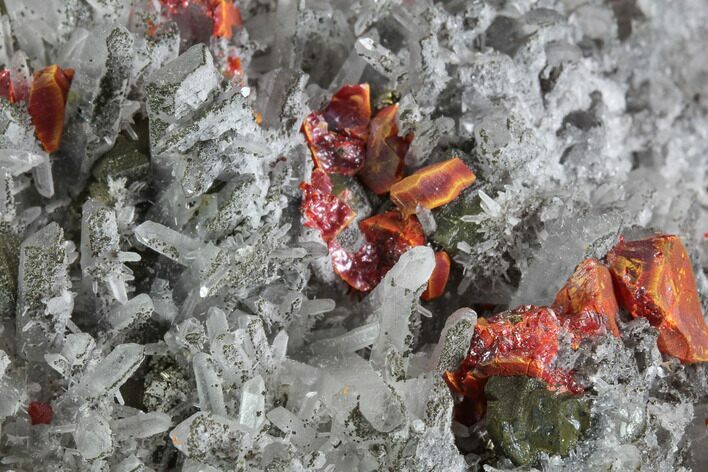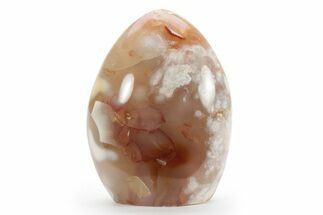This Specimen has been sold.
3.9" Realgar, Pyrite On Quartz - Peru
This fantastic specimen contains beautiful red realgar crystals and pyrite clinging to an aggregation of quartz crystals, collected from the Palomo Mine in Perú. Pyrite crystals can be found on what could be considered the bottom of the specimen, within the matrix.
About Realgar
Realgar is an arsenic sulfide mineral with the chemical formula of AsS. Realgar is known for its lustrous red hue, and pristine specimens can be transparent with sharp crystals. The crystal structure is typically stubby and prismatic, though botryoidal and earthy clumps can form as well.
Following prolonged/repeated periods of time under light, realgar will alter to pararealgar. If further left exposed, the pararealgar will crumble to a yellow dust. This mineral instability is particularly troublesome for museums where consistent light exposure has caused specimens to crumble over time. However, short, periodic exposure to light shouldn't alter realgar specimens.
Realgar contains a significant amount of poisonous arsenic, making it somewhat toxic. Therefore, we recommend washing your hands following handling.
Realgar is an arsenic sulfide mineral with the chemical formula of AsS. Realgar is known for its lustrous red hue, and pristine specimens can be transparent with sharp crystals. The crystal structure is typically stubby and prismatic, though botryoidal and earthy clumps can form as well.
Following prolonged/repeated periods of time under light, realgar will alter to pararealgar. If further left exposed, the pararealgar will crumble to a yellow dust. This mineral instability is particularly troublesome for museums where consistent light exposure has caused specimens to crumble over time. However, short, periodic exposure to light shouldn't alter realgar specimens.
Realgar contains a significant amount of poisonous arsenic, making it somewhat toxic. Therefore, we recommend washing your hands following handling.
About Quartz
Quartz is the name given to silicon dioxide (SiO2) and is the second most abundant mineral in the Earth's crust. Quartz crystals generally grow in silica-rich environments--usually igneous rocks or hydrothermal environments like geothermal waters--at temperatures between 100°C and 450°C, and usually under very high pressure. In either case, crystals will precipitate as temperatures cool, just as ice gradually forms when water freezes. Quartz veins are formed when open fissures are filled with hot water during the closing stages of mountain formation: these veins can be hundreds of millions of years old.
Quartz is the name given to silicon dioxide (SiO2) and is the second most abundant mineral in the Earth's crust. Quartz crystals generally grow in silica-rich environments--usually igneous rocks or hydrothermal environments like geothermal waters--at temperatures between 100°C and 450°C, and usually under very high pressure. In either case, crystals will precipitate as temperatures cool, just as ice gradually forms when water freezes. Quartz veins are formed when open fissures are filled with hot water during the closing stages of mountain formation: these veins can be hundreds of millions of years old.
About Pyrite
The mineral pyrite, also known as iron pyrite, is commonly referred to as Fool's Gold because its metallic luster and pale brass-yellow hue give it a superficial resemblance to gold. In the old mining days, pyrite was sometimes mistaken for gold.
It is the most common of the sulfide minerals with the chemical formula FeS2. Pyrite crystals occur in many shapes and habits, including cubes of all sizes, penetration twin cubes, pyritohedral clusters and as small druzy crystals that can exhibit a beautiful glistening effect.
The mineral pyrite, also known as iron pyrite, is commonly referred to as Fool's Gold because its metallic luster and pale brass-yellow hue give it a superficial resemblance to gold. In the old mining days, pyrite was sometimes mistaken for gold.
It is the most common of the sulfide minerals with the chemical formula FeS2. Pyrite crystals occur in many shapes and habits, including cubes of all sizes, penetration twin cubes, pyritohedral clusters and as small druzy crystals that can exhibit a beautiful glistening effect.
SPECIES
Realgar, Pyrite & Quartz
LOCATION
Palomo Mine, Perú
SIZE
3.9" long, 3.7" wide
CATEGORY
ITEM
#89357
 Reviews
Reviews














